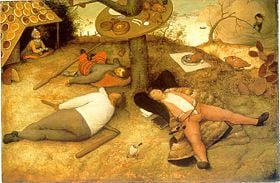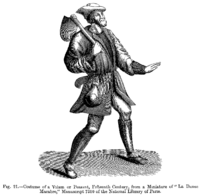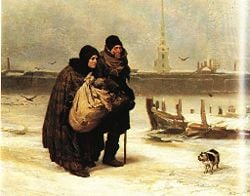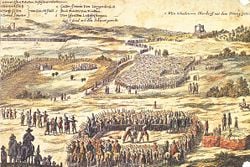Peasant
The peasant is an agricultural worker with roots in the countryside in which he or she dwells, either working for others as a tenant farmer or owning and working by his or her own labor a small plot of ground. The basic unit of peasant labor is the family or household, and a defining characteristic is self-sufficiency.
Peasants often were unfairly exploited. Unfree peasants under feudalism were known as serfs, and the existence of serfdom was rather widespread and longlasting, with serfs bound to their masters in a system of modified slavery. Peasant revolts coincided with the Protestant Reformation, which brought the concept of the equality of all people and the rights of all people to be children of the same God. The Enlightenment provided many political tools and scientific advances in farm technology to accomplish this. In the twentieth century, peasants still revolted in less developed countries, largely spurred by the images of more democratic and mutually beneficial governances.
The transition to societies that are primarily urban as opposed to rural has not been easy, nor is it clear that it is an ideal situation. The dream of the ancient Roman senator and soldier was to return home to his rural villa, and to enjoy the beauty of the land. Most Utopian visions have included much more of the natural world than visions of vast urban settings. However, the economics of how this all works has been very difficult to envision. Alvin Toffler suggested in Future Shock that "high tech" creates the need for "high touch," with nature being very "high touch." Perhaps the future will find a reconciliation through technology of human beings' needs to access one another and various resources, fulfill economic stability, and be one with nature like the peasants of the past.
Background
Historically, peasant is a word for farmer. The word "peasant" derives from fifteenth century French paĂŻsant meaning one from the pays, the countryside or region (from Latin pagus, country district). But in the world, in Europe at least, before the development of individual ownership, free trade, and democracy, to be a peasant meant to stay alive. All land was owned by various aristocracy or state governments, and as the modern division of labor and industry had not developed, the way to eat was to cultivate the land.
Since the literate classes who left the most record tended to dismiss the peasants as figures of coarse appetite and rustic comedy, "peasant" may have had a pejorative rather than descriptive connotation in historical memory. However, it was not always that way; peasants were once viewed as pious and seen with respect and pride. Life was hard for peasants, but before modern technology and a money economy, life was hard for everyone. Society was organized in three "estates": those who work, those who pray, and those who fight.
Peasants typically make up the majority of the agricultural labor force in a Pre-industrial society, depending on the cultivation of their land: without stockpiles of provisions they thrive or starve according to the most recent harvest. Pre-industrial societies have diminished with the advent of globalization and as such there are considerably fewer peasants to be found in rural areas throughout the world. However, there are still peasant populations in areas of the United States, Mexico, Central America, South America, Africa, India, China, Europe, and various parts of Southeast Asia.
Peasants were part of their land and depended on it. A peasant had to be a jack-of-all trades, handy at everything and able to solve all problems that came up. Fernand Braudel devoted the first volume of his major work, Civilization and Capitalism 15thâ18th Century to the largely silent and invisible world that existed below the market economy, in The Structures of Everyday Life. Peasants lived within agricultural timeâthe seasons and the weather were the realities of life; the "world-time," in Braudel's term, of politics and economics did not directly affect the peasant. Peasants typically made up the majority of the population. In modern society, where a market economy has taken root, the term may be more loosely referring to the traditionalist rural population where land is chiefly held by smallholders, "peasant proprietors."
A rural peasant population differs enormously in its values and economic behavior from an urban worker population. Peasants tend to more conservative than urbanites, and are often very loyal to inherited power structures that define their rights and privileges and protect them from interlopers, despite their generally lower status within their society.
Peasant societies developed strong social support networks. Especially in harder climates, members of the community who had a poor harvest or suffered some form of hardship were often taken care of by the rest of the community. Loyalties and vengeance both ran very deep. Thus, peasant communities can be difficult to access or understand by outsiders.
The Medieval European peasant
The relative position of Western European peasants greatly improved after the Black Death unsettled medieval Europe, granting far greater economic and political power to those peasants fortunate enough to survive the cataclysm. The respect and power inherent in food production was at a high point. In the wake of the disruption of the established hierarchy, later centuries saw the invention of the original printing presses, widespread literacy, and the enormous social and intellectual changes in the Protestant Reformation and the Enlightenment. The development of these ideas laid the groundwork for the Industrial Revolution, which enabled mechanically and chemically augmented agricultural production while simultaneously increasing the demand for factory workers in cities. The factory workers were low skilled and easy to replace and quickly came to occupy the same socio-economic stratum as the original medieval peasants. The tension between the interests of these two groups forms an underlying context for much of the subsequent social and economic debate. Much of this dialogue was applied to regions that were culturally very different from nineteenth century Western Europe.
This is especially pronounced in Eastern Europe. Lacking any catalysts for sweeping change in the fourteenth century, the Eastern European peasants largely continued upon the original medieval path until the eighteenth and nineteenth centuries, when the tsars began to notice that the West had made enormous strides they had not. They responded by forcing the largely illiterate peasant populations under their control to embark upon a Westernization and industrialization campaign. Using methods of coercion and inept central planning that were largely continued by the later Communists; Peter the Great initiated a half-successful attempt to force over five hundred years worth of social change into the space of a few generations. Although this approach eventually (under the Communists) produced a technologically advanced and literate population, it came at the cost of many millions of lives and a cultural legacy that persists to this day.
European Peasant Revolts
The change in fortune of peasants did not come without effort and, in many cases, a high price. Some examples of peasant revolts in Europe follow.
Peasant revolt in Flanders 1323-1328
The Peasant revolt in Flanders began as a series of scattered rural riots in late 1323, and peasant insurrection escalated into a full-scale rebellion that dominated public affairs in Flanders for nearly five years. The revolt was caused by excessive taxations levied by Count Louis I of Flanders, and by his pro-French policies. The insurrection had urban leaders and rural factions which took over most of Flanders by 1325. The king of France directly intervened and the uprising was decisively put down at the Battle of Cassel in August 1328.
English peasants' revolt of 1381
The English peasants' revolt was precipitated by heavy-handed attempts to enforce the third poll tax, first levied in 1377 supposedly to finance military campaigns overseasâa continuation of the Hundred Years' War initiated by King Edward III of England. The Black Death had greatly reduced the labor force, and as a consequence, laborers had been able to demand enhanced terms and conditions. The Statute attempted to curb this by pegging wages and restricting the mobility of labor. Probably those laborers employed by lords were effectively exempted, but those laborers working for other employers, both artisans and more substantial peasants, were liable to be fined or held in the stocks. As result, this rebellion had representations from members of these classes as well as peasants.
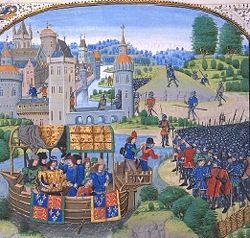
In June of 1831, "Wat" Tyler brought a contingent from Kent and the 'Men of Essex' had gathered with Jack Straw. The renegade Lollard priest, John Ball, preached a sermon for them that included the famous question that has echoed down the centuries: "When Adam dug and Eve span, who was then a noble man?"[1] The rebels were encouraged by this, and crossed London Bridge into the heart of the city the next day and began a systematic attack on certain properties, many of them associated with John of Gaunt and/or the Knights of Hospitaller Order. On June 14, they are reputed to have been met by the young king himself, and to have presented him with a series of demands, including the dismissal of some of his more unpopular ministers and the effective abolition of serfdom.
Meanwhile, a group of rebels stormed the Tower of Londonâafter likely being let inâand summarily executed those hiding there. Richard II of England agreed to reforms such as fair rents, and the abolition of serfdom.
At Smithfield, London, on the following day, further negotiations with the king were arranged, but on this occasion the meeting did not go according to plan. Wat Tyler is alleged to have behaved belligerently when negotiating with the King, and in the ensuing dispute Tyler was killed. King Richard seized the opportunity and tricked the rebels, allowing the Nobles to re-establish their control with the help of a hastily organized militia. Following the collapse of the revolt, the king's concessions were quickly revoked, and the tax was levied.
Slovenian peasant revolt of 1515
The Slovenian revolt of 1573 was a large peasant revolt in Croatia and what is now Slovenia. The revolt, sparked by cruel treatment of serfs by a local baron, ended after 12 days with the defeat of the rebels and bloody retribution by the nobility.
German peasants war of 1524-1525
The Peasants' War was a popular revolt in Europe in 1524-1525. It consisted, like the preceding Bundschuh movement and the Hussite Wars, of a mass of economic as well as religious revolts by peasants, townsfolk, and nobles. The movement possessed no common program. The conflict was in the southern, western, and central areas, but also affected Switzerland and Austria. There were about 300,000 peasant insurgents: contemporary estimates put the dead at 100,000. The revolt was in many respects a direct consequence of the Protestant reformation, which taught that all people were valued by God and could access God directly without the need of priestly mediation. Some translated this into the political realm, arguing that all people, regardless of social rank, should participate in governance.
Swiss peasant war of 1653
The population of the Swiss countryside demanded fiscal relief from their ruling authorities, which were the city councils of these cantons' capitals, to begin what has become known as the Swiss peasant war of 1653. When peasant demands were dismissed by the cities that ruled them, the peasants organized themselves and threatened to blockade the cities. What originally began as a response to the increase in taxes caused by a devaluation of Bernese money began to encompass demands of a much broader nature. The peasants formed a confederation called the "League of Huttwil" and negotiated the treaty of Huttwil.
When the terms of this treaty were broken the peasants laid siege on Berne and Lucerne, whereupon the cities negotiated a peace agreement with the peasant leader Niklaus Leuenberger, the so-called peace on the Murifeld. The peasant armies retreated, but troops from the federal council of the Old Swiss Confederacy were sent from ZĂźrich to put an end to the rebellion. Soon after the Battle of Wohlenschwil, the Huttwil League and the peace of the Murifeld were forcibly annulled. After their victory, the city authorities took drastic punitive measures. Many exponents of the insurrection were captured, tortured, and finally received heavy sentences. Niklaus Leuenberger was beheaded and quartered in Berne on September 6, 1653.
Although the military victory of the absolutist city authorities was complete, the war had also shown them that they depended very much on their rural subjects. Soon after the war, the ruling aristocrats instituted a series of reforms and even lowered some taxes, thus fulfilling some of the peasants' original fiscal demands. In the long term, the peasant war of 1653 prevented Switzerland from an excessive implementation of absolutism as occurred in France during the reign of Louis XIV.
1907 Romanian Peasants' Revolt
The Romanian Peasants' Revolt took place in March 1907 in Moldavia and it quickly spread, reaching Wallachia. The main cause was the discontent of the peasants about the inequity of land ownership, which was in the hands of just a few large landowners who did not want to bother with good administration of these lands. There were middle men hired, called (arendaĹi) who in exchange for a fixed rent would administer the land and try to make a good profit in a short time. Most of these middle men were not ethnically Romanian, being Jewish or Greek. They owned as much as half the arable land while Romanian peasants formed up to 80 percent of the Romanian population and about 60 percent of them holding very little or no land at all.
When one large land owner, Mochi Fischer, fled before signing contracts as customary with the peasants, the peasants became fearful. The fear of remaining out of work, combined with the activities of some alleged Austro-Hungarian instigators, led the peasants to revolt. The revolt soon spread across most of Moldavia, with several landowners' properties destroyed and many arendaĹi killed or wounded. The Conservative government (Partidul Conservator) could not handle the situation and resigned, so the Liberals (Partidul NaĹŁional-Liberal) of Dimitrie Sturdza assumed power.
On March 18 a state of emergency was declared, then general mobilization, with 140,000 soldiers being recruited by March 29. The Romanian Army began firing on the peasants; thousands of peasants perished and more than 10,000 were arrested. Although the figure is unclear, the most commonly cited death toll is around 11,000.
Notes
- â Literature of Richard II's Reign and the Peasants' Revolt Edited by James M. Dean. Originally Published in Medieval English Political Writings (Kalamazoo, MI: Medieval Institute Publications, 1996) Retrieved November 14, 2007.
ReferencesISBN links support NWE through referral fees
- Blum, Jerome. 1961. Lord and Peasant in Russia From the Ninth to the Nineteenth Century Princeton University Press. Retrieved November 15, 2007.
- Braudel, Fernand. 1992. The Structures of Everyday Life. Vol I of Civilization and Capitalism. ISBN 0520081145
- Kishlansky, Mark. 2001. Civilization in the West. ISBN 0321070909
- Ladurie, Emmanuel Le Roy. 1979. Montaillou: The Promised Land of Error. Vintage. ISBN 978-0394729640
- Mollat, Michael. 1986. The Poor in the Middle Ages. ISBN 978-0300027891
- TeBrake, William H. 1993. A Plague of Insurrection: Popular Politics and Peasant Revolt in Flanders, 1323-1328. ISBN 0812232410
This article incorporates text from the EncyclopĂŚdia Britannica Eleventh Edition, a publication now in the public domain.
Credits
New World Encyclopedia writers and editors rewrote and completed the Wikipedia article in accordance with New World Encyclopedia standards. This article abides by terms of the Creative Commons CC-by-sa 3.0 License (CC-by-sa), which may be used and disseminated with proper attribution. Credit is due under the terms of this license that can reference both the New World Encyclopedia contributors and the selfless volunteer contributors of the Wikimedia Foundation. To cite this article click here for a list of acceptable citing formats.The history of earlier contributions by wikipedians is accessible to researchers here:
The history of this article since it was imported to New World Encyclopedia:
Note: Some restrictions may apply to use of individual images which are separately licensed.
